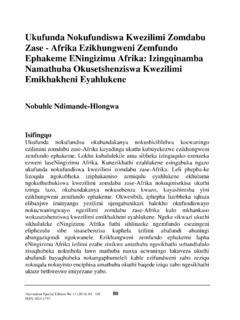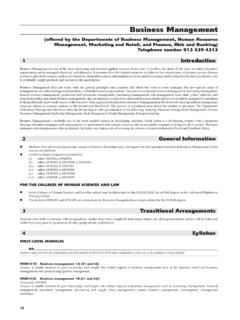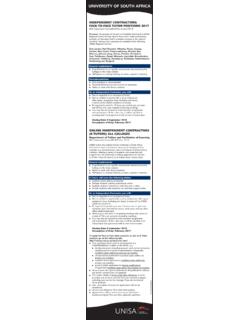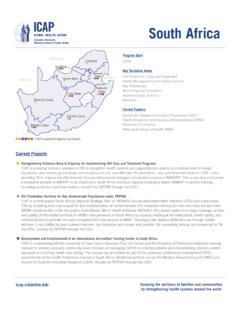Transcription of Addressing Student Dropout Rates at South …
1 Alternation Special Edition No 17 (2015) 91 115 91 ISSN 1023-1757 Addressing Student Dropout Rates at South african universities Padhma Moodley Rachael Jesika Singh Abstract The excitement of a South african University acceptance is shortlived, for many students , as the challenges faced is often overwhelming, resulting in many dropping out in their first year of study. This has negatively impacted on the desired national norm of an 80% success rate targeted by the Department of Higher Education and Training.
2 This study aims to explore ways in which the Dropout Rates can be reduced thereby increasing the throughput levels of universities in South Africa. A qualitative study was conducted to identify the challenges students encounter that lead to the high Dropout Rates . students who had previously dropped out from universities in South Africa were interviewed in order to examine their perceptions of how dropping out of university could have been avoided. Snowball sampling, a type of purposive sampling was used in this study.
3 The findings indicate incorrect career choice, inadequate academic support and insufficient funding as being primary factors that led to the drop out of students . One of the recommendations this study makes is that university departments must align their support programmes with modules that have a high failure rate to help students cope. Keywords: Dropout , Student , academic support, university, throughput. Introduction The ever increasing number of students who drop out of university remains a Padhma Moodley and Rachael Jesika Singh 92 major area of concern among Higher Education administrators.
4 This intractable challenge has been the focus of many scholars globally. In response to this, Student retention strategies have been adopted in a bid to remedy the situation. However, the problems and challenges persist year in and year out. Pocock (2012) in his research on Student attrition in an engineering faculty in South Africa explains the various terminologies used to describe students who do not return to university. Among these are Dropout which he deems as having a negative connatation because of its use in common phraseology; attrition , which from an engineering perspective implies the chipping of particles from a large piece of material, usually as either a deliberate action of a grinding mill or through incidental and unwanted collisions between materials; and leaving without graduating which he deemed as being a more forgiving term.
5 In a more recent study by Larsen et al. (2013), the term Dropout is said to be commonly used to describe situations where a Student leaves the university study without having obtained a formal degree. Furthermore, from a Student s perspective the terms used to describe Dropout are: departure, withdrawal, academic failure and non- continuance. From an institutional perspective the term Student attrition is commonly applied to Dropout (Jones 2008:1). However, taking these distinctions taken into cognisance, this article uses the words Dropout and attrition interchangeably.
6 In South Africa, recent reports (Monama 2013; Smith 2013) indicate that 5% of black and coloured students graduate from university. This demands the need for a more strategic and innovative approach to address the problem of Dropout , especially amongst previously disadvantaged groups. It is unfortunate that a reactive approach has to be taken, considering that the issue of Student retention is a challenge encountered by universities globally, for example, Victoria University in Australia attrition Rates were around 25% for the period between 1994 2003 (Gabb & Cao 2006); University of Leeds 8,6%; University of Edinburgh (Johnston 2005).
7 Fisher & Engemann (2009) state that Ontario s universities had an attrition rate of 43% between 1998-2003. In a study conducted by Pillay & Ngcobo (2010:234), stress factors such as accommodation issues; financial difficulties in addition to the academic demands made it difficult for students to progress through to the next year. The study further revealed that one in eight students believed they Addressing Student Dropout Rates at South african universities 93 had not made the right choice of study.
8 This was as a result of very limited information being made available at the point of their career choice. Du Plessis & Gerber (2012) also looked into the proficiency of the medium of instruction which in many cases is English which students could not cope with, as this impacted on their reading and processing skills. These are just some challenges students face which can be associated with their reasons for dropping out of university. As a pre-emptive measure to maintain healthy throughput levels at universities , this study explores the determinants of Student attrition within the context of the South african Higher Education landscape.
9 Subsequently concrete remedies are proposed in light of this problem. Whilst the problem of attrition is not unique to South Africa, some of the circumstances that forms the catalyst for the problem are unique. Previous research is evaluated against similar scenarios in South Africa to provide a framework of understanding this epidemic that plagues our universities . Scanning the South african Higher Education Landscape In order to provide the study with a comprehensive perspective on Student attrition from a South african viewpoint, previous literature and research conducted in the area of Student attrition is examined in order to understand more specifically the nature of the problems experienced at individual and institutional level.
10 A report compiled by Moeketsi & Maile (2008) for the the Human Sciences Research Council, revealed that in 2005, the Department of Education reported that of the 120 000 students who enrolled in higher education in 2000, 36 000 (30%) dropped out in their first year of study. A further 24 000 (20%) dropped out during their second and third year. Of the remaining 60 000, 22% graduated within the specified three-year duration for a generic Bachelors degree. This Dropout cost the National Treasury billion in grants and subsidies to higher education institutions without a return on the investment.













